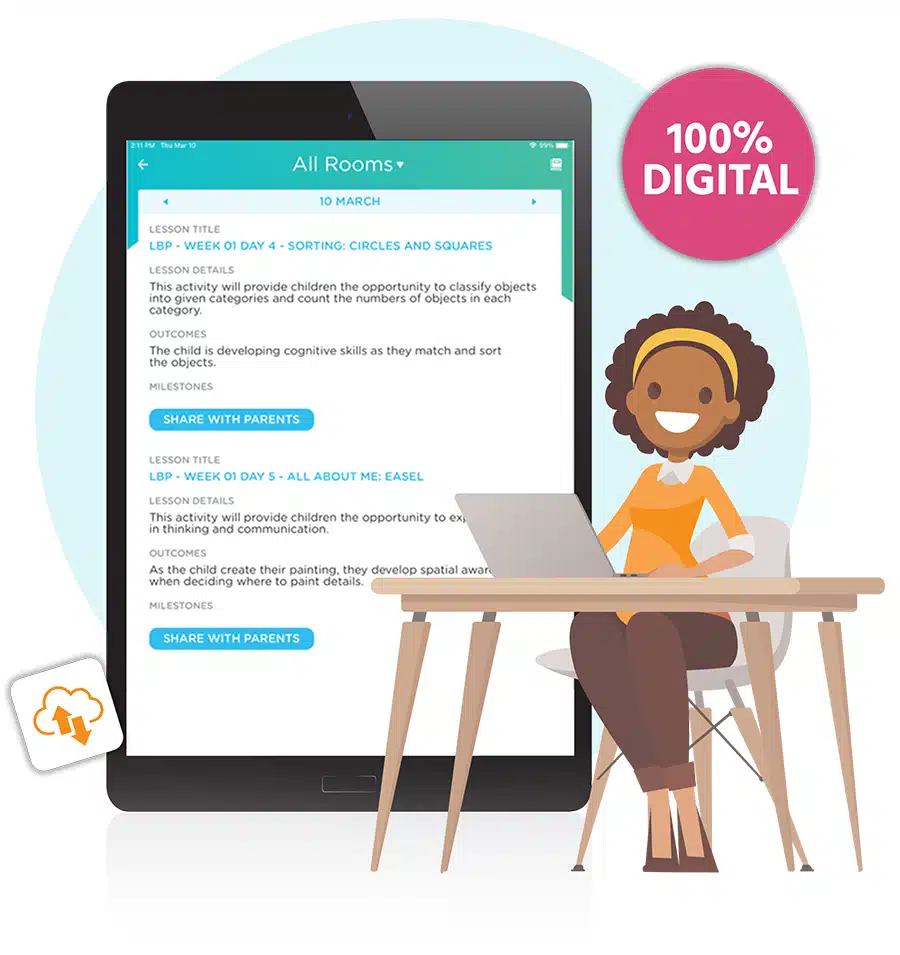
Scaffolding in early childhood education helps early childhood educators guide children as they learn.
Let’s take a deeper look and answer some key questions about early childhood scaffolding and share some examples for incorporating scaffolding in your child care classrooms!
What is Scaffolding in Early Childhood Education?
Scaffolding is a teaching strategy that originated from the works of Russian psychologist Lev Vygotsky. It involves providing successive levels of temporary support that help students achieve higher levels of understanding and learning skills.
The definition of scaffolding in early childhood education means giving children the support they need to succeed at tasks they initially cannot complete independently. It is how adults support children’s development and learning by offering just the right help at just the right time in just the right way, according to the National Association for the Education of Young Children.
This method evolves as a child’s capabilities grow, gradually removing the support as their skills develop.
The Benefits of Early Childhood Scaffolding
Scaffolding in early childhood education offers many benefits that contribute to a child’s cognitive, social and emotional development:
1. Enhanced Learning Outcomes
By tailoring the level of support to a child’s current abilities, scaffolding helps make complex tasks more manageable and achievable. This structured approach fosters better understanding and retention of new concepts.
2. Promotes Independence
As support is gradually removed, children become more confident in their abilities and are encouraged to take on more challenging tasks independently. This gradual release of responsibility builds self-efficacy and problem-solving skills.
3. Encourages Social Interaction
Scaffolding often involves collaborative learning in which children work together and learn from each other under guided supervision. This interaction develops social skills and teamwork capabilities.
4. Builds a Strong Foundation
Providing the right amount of guidance helps children build a solid foundation for future learning. Early successes and positive experiences with challenging tasks foster a love for learning and intellectual curiosity.
Examples of Scaffolding in Preschool
The ultimate goal of scaffolding is to see students learn and grow, according to Rasmussen University. With scaffolding, a lesson can be fitted to the learning style of the student.
The university gives this example: Let’s say a visual learner is struggling to comprehend a story. With scaffolding, the instructor could preview the text and offer visual examples of key vocabulary and concepts. This way, the child receives the text in pieces that make sense to him or her to put together to understand the whole thing.
This is one of the greatest benefits of scaffolding – it leaves room for all types of students to learn the same thing in a way that makes sense to them!
Asking questions in early childhood scaffolding is key. Check out these questions that encourage children to think critically and reflect on their learning process to deepen their understanding and engagement:
- What do you think will happen if we try this?
- Can you show me how you would do this?
- Why do you think this is important?
- What could you do differently next time?
Let’s go deeper look at other scaffolding examples in four specific learning areas!
1. Language Development

Scenario: A preschool educator is helping children develop their vocabulary and sentence structure.
Technique: The educator uses picture cards depicting various objects, animals and actions. When showing a card of a dog running, the educator might say, “This is a dog. The dog is running. What is the dog doing?”
Scaffolding Process: Initially, the educator provides complete sentences, modeling the language use. As children become more familiar, the educator encourages them to describe the images themselves by offering prompts like, “Can you tell me what the dog is doing?” Gradually, the children start forming their own sentences with confidence.
2. Mathematical Concepts
Scenario: An educator is teaching children to count and recognize numbers.
Technique: Using colorful counting blocks, the educator demonstrates counting to 10, emphasizing each number verbally and visually.
Scaffolding Process: At first, the educator counts alongside the children, ensuring they understand. As children become more comfortable, they are encouraged to count on their own, with the educator stepping in only when necessary to guide or correct. Over time, children gain independence in counting and recognizing numbers, building a solid mathematical foundation.
3. Problem Solving and Critical Thinking
Scenario: A group of children is working on a puzzle.
Technique: The educator observes the children’s attempts and offers hints or suggestions to guide them toward the solution.
Scaffolding Process: Initially, the educator might demonstrate how to find corner pieces and edges, providing direct assistance. As the children progress, the educator reduces their involvement, allowing the children to attempt solving the puzzle independently, stepping in only to provide minimal hints or encouragement.
4. Social and Emotional Development

Scenario: An educator is helping a child navigate conflict resolution with peers.
Technique: The educator models appropriate language and behaviors for resolving conflicts, such as using “I” statements and expressing feelings constructively.
Scaffolding Process: The educator first engages directly in the conflict, demonstrating how to communicate feelings and solutions. As the child becomes more adept, the educator encourages them to handle conflicts independently, stepping in only to mediate or provide guidance when necessary. This approach helps children develop crucial social skills and emotional intelligence.
How to Implement Scaffolding in Your Preschool Classroom
Implementing scaffolding strategies in a preschool setting requires thoughtful planning and an understanding of each child’s unique needs. Here are some practical steps to get started:
1. Assess the Child’s Current Level
Begin by identifying what the child can do independently and where they require assistance. This assessment will help you determine the appropriate starting point for scaffolding.
2. Set Clear Objectives
Define what you want the child to achieve through the scaffolded activity. Clear, attainable goals will guide your support and help measure progress.
3. Break Tasks into Smaller Steps
Divide complex tasks into smaller, more manageable steps. Provide support for each step, gradually increasing complexity as the child becomes more proficient.
4. Use Various Scaffolding Techniques
Different techniques can be employed based on the task and the child’s needs. These include:
- Modeling: Demonstrate the task or behavior yourself.
- Guided Practice: Work through the task alongside the child.
- Prompting: Provide hints or cues to encourage the child to think critically.
- Questioning: Ask open-ended questions to stimulate thinking and problem-solving.
5. Monitor and Adjust Support
Continuously observe the child’s progress and adjust the level of support accordingly. Offer more assistance when needed and gradually withdraw it as the child becomes more capable.
Hints and Suggestions to Aid Scaffolding
To effectively scaffold in early childhood education, educators should incorporate various strategies and techniques tailored to individual needs. Here are some hints and suggestions to consider:
Hints:
- Visual Aids: Use pictures, charts, and visual cues to help children understand complex concepts.
- Storytelling: Incorporate stories that relate to the task at hand, making abstract ideas more concrete.
- Repetition: Reiterate key points and steps frequently to reinforce learning.
- Encouragement: Offer positive reinforcement and praise to build confidence and motivation.
Suggestions:
- Create a Supportive Environment: Establish a classroom atmosphere that is safe and encouraging, where children feel comfortable taking risks and making mistakes.
- Peer Learning: Encourage children to work in pairs or small groups, allowing them to learn from each other and collaborate.
- Interactive Activities: Incorporate hands-on activities and games that make learning fun and engaging..
How an ECE Digital Curriculum Aids Scaffolding!

Scaffolding helps identify gaps between what children know and what they still have to learn. This requires a consistent assessment of progress.
A strong digital curriculum that’s easy to use can support you in providing these assessments.
Procare Early Learning is an all-digital curriculum specifically designed to meet the unique needs of educating children from infancy through pre-kindergarten.
With this curriculum, there’s no more recording your assessments on paper. The built-in assessment tool helps teachers observe and plan for individual children right from within Procare on their tablet or mobile device. Procare also enables the ability to create custom assessments!
It embeds Learning Beyond Paper’s early childhood curriculum, which was designed by educators with decades of combined experience, into Procare, making it easier and less time-consuming for busy teachers and administrators to provide high-quality education.
And it’s saving one child care center in West Virginia up to $1,600 a month!
With Procare Early Learning powered by Learning Beyond Paper, child care centers can:
- Equip teachers with state-of-the-art online curriculum at their fingertips
- Dramatically reduce the amount of time spent on lesson planning each week
- Offer children a high-quality, developmentally appropriate curriculum
- Save money with this cost-efficient solution that’s integrated with Procare
This curriculum can be used in ALL child care center classrooms, with 52 weeks of lesson plans and more than 4,000 daily activities for infants, toddlers, preschoolers and pre-kindergarteners. Learning areas include STEAM, language and literacy, physical development, cognitive, music and movement as well as interactive reading. Plus, teachers get tips and tools they can use in real time.
Procare is the only solution that can deliver the entire early childhood education ecosystem — lesson planning, lesson delivery within the classroom as well as assessment and parent engagement. Being able to do all of these with one platform simplifies classroom management and planning!
How much time and money could your child care center save using a digital curriculum designed for young learners? Enter your number of staff, number of students and type of program into our online calculator to see your potential time and money savings!


